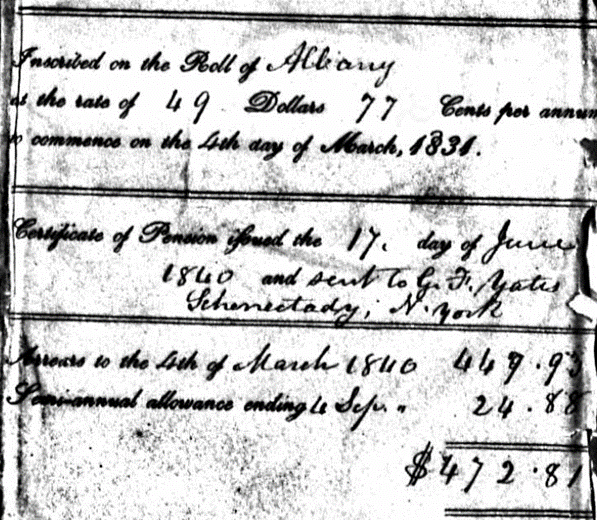Takel Ouderkerk
Takel Ouderkerk was baptized in Schnectady, New York on June 11, 1758, so was born before that date. His parents were Peter Ouderkirk and Machteldt Heemstraat. Takel was a great grandson of Jan Janse Ouderkerk. Much of what I have learned about Takel was from a Land Petition in 1816 and the Revolutionary War Pension and Bounty-Land Warrant Application Files, 1800-1900, submitted in 1838 by his widow, Maria Ouderkerk. I have noted that the surname is spelled Ouderkirk and Ouderkerk throughout various records. Takel has many spellings as well.
I did locate Toukel (sic) Ouderkerk as an enlisted man in the following book I found online which confirms that he fought in the Revolutionary War.
New York in the Revolution as Colony and State Vol. I
A Compilation of Documents and Records from The Office of the State Comptroller
ALBANY, N. Y.
J. B. Lyon Company, Printers
1904
[Transcribed by Coralynn Brown]
ALBANY COUNTY MILITIA (Land Bounty Rights) - Third Regiment
CAPT. John Vanderheyden CAPT. Abraham Vader
ENLISTED MEN
Ouderkerk Andrew
Ouderkerk Toukel
Ouderkirk Cornelius
Ouderkirk Isaac
Outerkerk B.
About 1800, Takel brought his family to Dundas County, Ontario and settled near the present town of Morrisburg. On February 23, 1816, Takel petitioned for a grant of the land - 50 acres of Lot A Concession V in Matilda Twp., and 50 acres of Lot 38 Concession V in Williamsburg Township, on which he had built a house and barn. As part of his petition, he stated that he had lived on the land about 16 years and had lost a son in the taking of Ogdensburg on February 22, 1813. This would have been his son, Frederick, next older brother to Hendrik. The petition was made through Takel's agent, John Crysler, who was a member of the Legislative Assembly representing Dundas from 1812-1820. The famous Battle of Crysler's Farm was fought on John's property on November 11, 1813.
The Surveyor General reported that both the land parcels Takel wanted belonged to the clergy reserve and so Takel was denied his petition. He was, however, granted a lifetime tenancy. The terms would have been 15 shillings per year for the first 7 years, 30 shillings for the next 7 years and 45 shillings for the last 7 years of a 21-year lease. For reasons unknown, Takel did not take the offer, and instead chose to return with his wife to Rotterdam, New York, where he died April 12, 1826. Takel was buried in the William S. Ward Cemetery in Rotterdam.
Takel’s Revolutionary War record was described in various affadavits in the Revolutionary War Pension application of Takel’s wife, Maria Ouderkirk, submitted on October 9, 1838. In an affadavit from deponent Isaac Groat, it was stated that Takel Ouderkirk worked as a fatigue man, batteauman, and labourer in the summer and fall of 1777 at Saratoga and Fort Miller. Fort Miller was on the Hudson River and was a gathering place of retreating Americans in July and August of 1777 during the American Revolution. The two stages of battle at Saratoga were September 19 and October 7, 1777. Groat stated that this campaign eventuated in the capture of Burgoyne (British General John Burgoyne).
Another deponent, William Cool, stated that he knew Takel Ouderkirk to be married to Mary or Polly Ouderkirk and that he did service in Stillwater in 1777. Stillwater is a village in Saratoga County.
A third deponent, Takel's brother Peter, stated that his brother had served at Fort Schoharie and that he believed in August of 1777 his brother was married to Polly Ramsey of the town of Gilderland (sic) by the Reverend Baur Vroman of that town. In Maria's pension application she stated the date of their marriage as June 12, 1777. So, it appears that while Takel did serve in the American army during the American Revolution, he did not take up arms. He just did the grunt work of the army. Guess that is how he lived through it.
Maria's war pension petition was successful and she was granted a pension in the amount of $49.77 per annum back dated to March 4, 1831. Maria received a lump sum of $472.81 on September 4, 1840 and then her yearly pension until she died in 1847. This would convert to a lump sum payment in 2024 of $16,501.18 and a yearly pension of $1,786.75. Maria was buried with Takel in the William S. Ward Farm Cemetery.

In looking at both the Land and the War Pension Petitions, I think it is safe to say that Takel was flexible in his loyalties to either country. He had likely been promised land when he took up arms with the Americans against the British in 1777. The fact that he crossed into Canada (what was then British North America) about 1800 and squatted on what he thought was common land leads one to believe that he never received the promised land in the United States. He then fought with the British against the Americans in the War of 1812. A few years later, when he was denied the land in Canada upon which he had built his home and barn, he returned to the United States. It seems a tad ironic then, that his wife lived her final years receiving a pension because Takel was sworn to be an American patriot. I guess one does what one has to in order to survive. The Ouderkerks/Ouderkirks have proven themselves to be great survivors of their times.